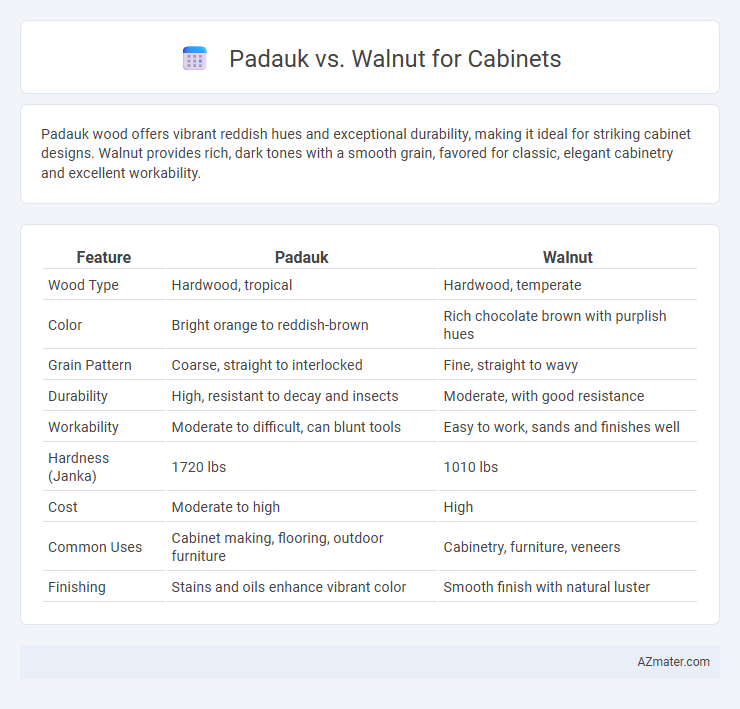Padauk wood offers vibrant reddish hues and exceptional durability, making it ideal for striking cabinet designs. Walnut provides rich, dark tones with a smooth grain, favored for classic, elegant cabinetry and excellent workability.
Table of Comparison
| Feature | Padauk | Walnut |
|---|---|---|
| Wood Type | Hardwood, tropical | Hardwood, temperate |
| Color | Bright orange to reddish-brown | Rich chocolate brown with purplish hues |
| Grain Pattern | Coarse, straight to interlocked | Fine, straight to wavy |
| Durability | High, resistant to decay and insects | Moderate, with good resistance |
| Workability | Moderate to difficult, can blunt tools | Easy to work, sands and finishes well |
| Hardness (Janka) | 1720 lbs | 1010 lbs |
| Cost | Moderate to high | High |
| Common Uses | Cabinet making, flooring, outdoor furniture | Cabinetry, furniture, veneers |
| Finishing | Stains and oils enhance vibrant color | Smooth finish with natural luster |
Introduction to Padauk and Walnut Wood
Padauk wood, known for its vibrant reddish-orange hue and exceptional durability, offers excellent resistance to decay and insect attacks, making it a popular choice for high-quality cabinetry. Walnut wood features a rich, dark brown color with intricate grain patterns, prized for its strength, stability, and smooth finish in fine furniture and cabinet making. Both hardwoods provide unique aesthetic appeal and long-lasting performance, with Padauk standing out for bold color and Walnut celebrated for classic elegance.
Key Differences Between Padauk and Walnut
Padauk wood is known for its vibrant reddish-orange color that darkens over time, contrasting with Walnut's rich, dark brown hue with occasional purplish tones. Padauk tends to be harder and more durable, making it highly resistant to wear and ideal for high-traffic cabinet surfaces, while Walnut offers a smoother finish and easier workability, valued for intricate detailing. In terms of grain, Padauk features a straight to interlocked texture providing a bold, exotic appearance, whereas Walnut typically presents a straight, fine-grained pattern that delivers a classic, elegant look.
Appearance and Color Variations
Padauk showcases a vibrant reddish-orange hue that deepens into a rich, dark red over time, offering striking contrast and warmth in cabinetry. Walnut presents a broad spectrum of colors from pale brown to deep chocolate, often featuring elegant, pronounced grain patterns that add sophistication. Both woods provide distinctive aesthetic appeal, with Padauk emphasizing bold, vivid tones and Walnut offering versatile, classic color variations suitable for diverse design styles.
Grain Patterns and Texture
Padauk wood features a bold, straight grain with occasional interlocking patterns, providing a striking and vibrant appearance ideal for modern cabinetry. Walnut boasts a more uniform, wavy grain with rich, smooth textures that exude classic elegance and warmth in cabinet design. The coarse yet even texture of Walnut contrasts with Padauk's fine, porous surface, influencing the finishing and durability of cabinetry projects.
Durability and Hardness Comparison
Padauk wood offers exceptional durability with a Janka hardness rating typically around 1,720, making it highly resistant to dents and wear. Walnut, with a lower Janka hardness of approximately 1,010, is softer and more prone to surface damage but provides a fine, rich grain favored for luxury cabinetry. For cabinet construction where durability and hardness are crucial, Padauk outperforms Walnut in resisting daily use and maintaining structural integrity over time.
Workability and Machinability
Padauk offers excellent workability due to its moderate density and smooth grain, allowing easy cutting, sanding, and shaping for cabinetry. Walnut features superior machinability with consistent grain patterns, reducing tear-out and enabling precise joinery and finishing. Both hardwoods provide reliable performance, but Padauk's slightly softer nature makes it more user-friendly for intricate cabinet details.
Cost and Availability
Padauk wood tends to be more expensive than walnut due to its exotic origin and vibrant color, which drives demand. Walnut is moderately priced and widely available in lumberyards and home improvement stores across North America and Europe. For budget-conscious cabinet projects, walnut offers better availability and consistent pricing compared to the higher cost and limited supply of padauk.
Finishing and Maintenance Needs
Padauk offers a vibrant reddish-orange hue that deepens with age, requiring regular oiling or waxing to maintain its rich color and prevent surface dullness. Walnut exhibits a deep brown tone with a smooth grain, benefiting from occasional cleaning and recoating with clear finishes to preserve its natural luster and resistance to scratches. Both woods demand periodic maintenance, but Padauk's color intensifies with exposure, whereas Walnut's classic appearance remains consistent under proper care.
Best Uses for Padauk vs Walnut Cabinets
Padauk cabinets are best suited for high-end furniture and cabinetry where vibrant reddish-orange hues and durability against wear are desired, making them ideal for accent pieces and statement kitchens. Walnut cabinets excel in classic and modern designs due to their rich brown color, tight grain, and excellent stability, perfect for traditional-style kitchens and luxury interiors. Both woods offer exceptional hardness and resistance, but Padauk's color makes it preferable for bold aesthetics, while Walnut provides timeless elegance and versatility.
Choosing the Right Wood for Your Cabinets
Padauk offers vibrant reddish-orange hues and natural durability that resist wear and insect damage, making it ideal for bold, long-lasting cabinets. Walnut features rich chocolate tones with a smooth grain pattern, providing timeless elegance and moderate hardness suited for high-end cabinetry. When choosing the right wood, consider Padauk for striking color and strength, while Walnut excels in classic beauty and workability.

Infographic: Padauk vs Walnut for Cabinet
 azmater.com
azmater.com